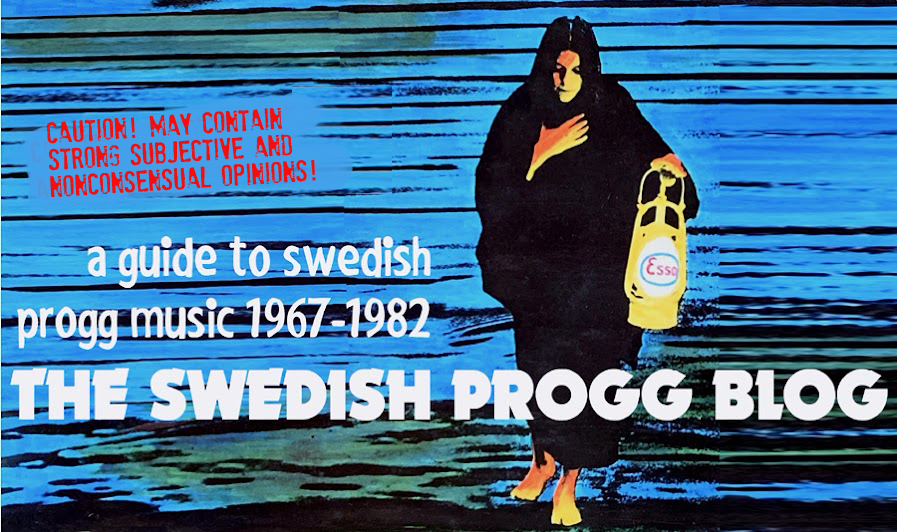Swedish vocals
Ranked #8 on the blog's Top 25 list
International relevance ***
If the words ”legendary” and
”classic” were invented for a reason, then ”Ja dä ä dä!” is
that reason. Generally considered the first proper rock album
entirely sung in Swedish, this is where the whole Swedish progg music
really began. True that bands like Baby Grandmothers and Hansson &
Karlsson had been going on prior to the release of Pugh's debut, but
this album took it all one step further. If not three steps further.
Because there had never been an album like this before, not in
Sweden, and not internationally.
It's an utterly groovy album (groovy as
in ”groovy, man!” and as in organic, swinging, moving rhythms), recorded after Pugh escaped mandatory military service.
The playing is top notch, loose and free and yet with excellent
discipline. It's amazing how richly textured a trio can be, but then
again, the musicians are among the very finest Sweden had to offer at
the time. Janne Carlsson is the Karlsson (note the change in
spelling!) in the aforementioned Hansson & Karlsson, while Georg
Wadenius, popularly known as Jojje, later had fame in Made in Sweden,
fortune in Blood, Sweat and Tears, and sheer excellence on the
children's album ”Goda' goda'”. He's best known as a guitarist so
it's curious to hear him pounding away on the bass on ”Ja dä ä
dä!”. Guitars are in fact played by Pugh himself; wild, stoned,
crazy guitars at its finest. In many ways, the trio is closer to jazz
than rock music. No wonder, as Carlsson was a jazz drummer from the
beginning.”Ja dä ä dä!”.
What makes this a Swedish classic is of
course the lyrics. Not only because it was the first time we had a
rock album sung entirely in Swedish, but also because Pugh had a very
original way to use the Swedish language. No one has every written
lyrics in a similar fashion as Pugh. They are deep and naive at the
same time. At a first glance they might appear as simple banalities,
but nothing could be further from the truth. There's a whole lot of
depth beneath the surface of the playful sentences, and it's a pity
that this is lost on a foreign listener not familiar to the Swedish
language. (He even touched on homsexuality in the song ”Du tände
lyset Andersson” – not a common topic in 60's lyrics.) But don't
let the language put you off, because even if you don't know a single
word of what Pugh sings, the music speaks on a level that can be
fully understood by anyone with a heart and a soul. The great playing
would mean nothing at all if it wasn't for the excellent songwriting.
”Ja dä ä dä!” doesn't have a single weak track.
 |
But it does offer some favourites. ”Här
kommer natten” is one of the best songs ever to emerge from the pen of a Swedish
songwriter, and ”Små lätta moln” is summer at its most
romantic. The cover of Kurt Weill's ”Surabaya Johnny” (in
Swedish, of course) slips effortlessly in with the original numbers.
When speaking of classic debut albums, this is among the very best.
A curious fact is that US label Vault
licensed this for an American release in 1970. Vault obviously
specialized in albums with no commercial potential whatsoever, but
even by their standards, ”Ja dä ä dä!” (renamed ”Ja da a da!”
for the domestic market – as if that would make any more sense!) is
among their very weirdest releases. The vocals weren't overdubbed
with English lyrics, but the back cover sported English translations
of the words, complete with some unintentional humour to Swedish
readers. (”You switched the light on Andersson” just doesn't
sound very catchy in English.) If the lyrics was a mystery even
translated, one can only imagine what troubles Pugh's name might have
caused over there. Pugh's real name is Torbjörn Rogefeldt, and even
that would have been a better name when trying to market his album to
non-Swedish record buyers. I mean, how do you pronounce Pugh? Like
”Pew”? ”Pewg”? ”Puff”? ”Pah”? The correct answer is
something like ”Puhgg” but who could tell?
I have no idea how many US copies were
pressed, but it's a safe bet that the lion's share of the edition
were shipped to Sweden. Every once in a while US copies turn up for
sale here, and I've seen more of these than of Swedish originals over
the years. (The album has since been rereleased many times. Those who take notes of sleeve variations, originals have the title in black lettering, whereas later copies are in white. It also comes with a foldout cover with an orange lyric sheet stapled to the spine inside. Also, blue record label.)
Another funny anecdote regarding Pugh
is that the politically questionable writer Michael Moynihan in his
book on the Norweigan black metal scene, ”Lords of Chaos”, stated
that Pugh was the guy behind Swedish black metal pioneers Bathory. I
can hereby clarify that this is NOT the case...
Hopefully, time has turned for the
better as regards this album's international appeal. What must have
been nothing more than a confusing curio on the international market
in 1970 ought to stand out as a striking masterpiece some 40 years
later. Given the ever growing interest in international progressive
music, this should be hailed worldwide as the true masterpiece it is.
Like I said, there never was an album like it, and I'll even go as
far as to say there never will.
By the way, the title means ”Yes, it
is!” and is spelled in the dialect of Västerås, the town where
Pugh grew up.







